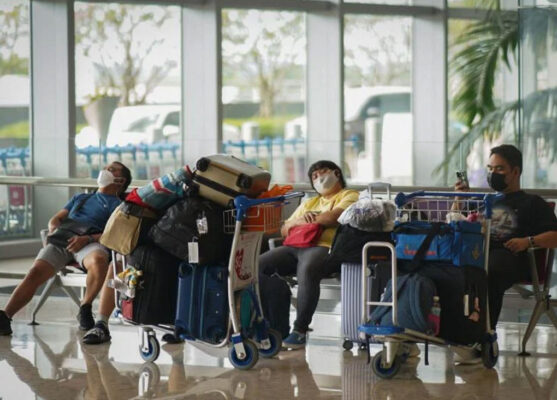At least 56,000 passengers at Asian airports were stranded after the Manila air traffic incident on January 1.
John Paul Ambon has been to Singapore 13 times, but January 1 was the first time he got stuck at Changi Airport. John arrived in Singapore for the Christmas holiday on December 24 and returned to the Philippines on New Year’s Day. Many tourists like John were also stuck at airports in Singapore, Japan, and the Philippines because of a power outage in the Philippines that forced the country to close its airspace.
According to the Manila International Airport Authority, at least 56,000 passengers were affected as of 16:00 on January 1 because of the incident. John was stuck in Terminal 2 after a Singapore Airlines (SIA) flight to Manila was delayed. His flight was supposed to take off at 14:05.

John said passengers are mostly sitting in lounges and departure areas. Some were shocked when they received the first delay notice at 13:45. He also chatted with guests who had flown out of Changi, were about to land in Manila, and then were redirected back to Singapore. Around 17:45 on the same day, John was informed that the flight took off at 21:30 but was not given food vouchers.
As observed by the Straits Times reporter, Changi Airport on the afternoon of January 1, groups of passengers were stuck sitting on chairs with tired spirits, some others slept. Most of them sit on their phones to kill time.
Darling Reterba, 52 years old, from the Philippines said he was very sad when the flight to Davao City (Philippines) was canceled. But added that “this is no one’s fault”. Reterba and his family of four traveled to Singapore to travel, intending to stay in Changi until the flight was rescheduled on 3/1. However, she still hopes to be able to return home sooner. “We’re tourists, so we don’t know where to go. So I can just stay here and wait,” Reterba said.
The situation is no better for tourists elsewhere in the region, according to the Straits Times. Singaporean male tourist Lawrence, 67, and his family are stuck on the tarmac at Haneda Airport (Tokyo, Japan). The reason was that their flight home at 9:20 am (local time) yesterday morning was delayed by 3 hours.
He said there was little explanation or announcement of the situation. Later, Lawrence added that the airline informed the flight to depart at 22:30 on the same day. Passengers are allowed to leave the plane to get food and then return. The airline mentioned the provision of food for guests. “I think the airline has tried its best in this situation,” the male tourist said.
A tourist named Billy said that many people were confused and worried when they arrived at the airport in Osaka (Japan) and received a notice that the trip was delayed until 22:25 on January 1, nearly 4 hours later than scheduled.
Jon V, a Filipino, said the flight to Singapore was supposed to land at 3:25 p.m. but had to turn around at Narita Airport, Tokyo midway. The pilot announced that the plane could not pass through Philippine airspace. They tried to reroute via Taipei or Hong Kong but were not allowed because both places were already overloaded. When the plane returned to Tokyo at 15:30, the airline’s staff distributed water and bread to passengers. John was given a meal voucher worth 1,000 yen (VND 180,000) and used it to buy a snack from the airport store. His flight to Singapore was announced to depart at 2 pm on January 2.
A representative of Scoot said that six flights between Singapore and the Philippines, Japan, and South Korea were affected. Some flights have been rescheduled, others had to be rescheduled due to the unresolved Philippine airspace incident. The person added that many flights could be affected.
SIA representatives confirmed that some of their flights were also affected on January 1, some had to return to the point of departure, and others landed at the airport instead. This person also said that many flights may be affected. A representative from Jetstar Aisa said that five flights from Singapore to the Philippines were affected. Philippine Airlines spokesman, Cielo Villaluna, said 40 international flights were canceled, and more than 130 domestic flights were also affected. On its website, Cebu Pacific Air said more than 230 flights were canceled.
On January 1, Philippine authorities announced that they were closing their airspace and stopping flights to and from Manila due to a power outage that resulted in a malfunction in the air traffic control system. A total of 282 flights were delayed, canceled, or diverted to other airports in the region, affecting about 56,000 passengers at Manila’s Ninoy Aquino International Airport (NAIA), the airport operator said.





